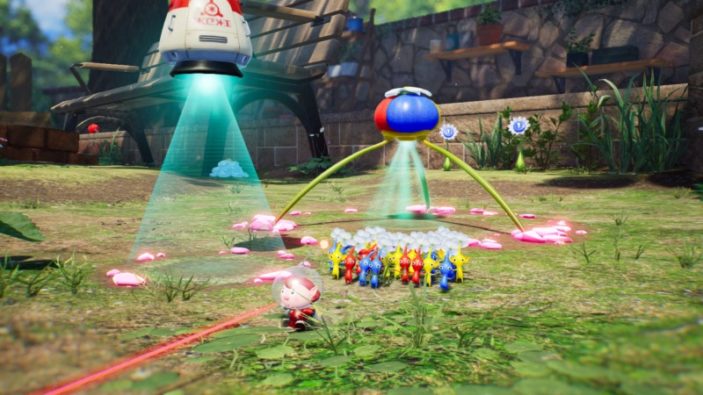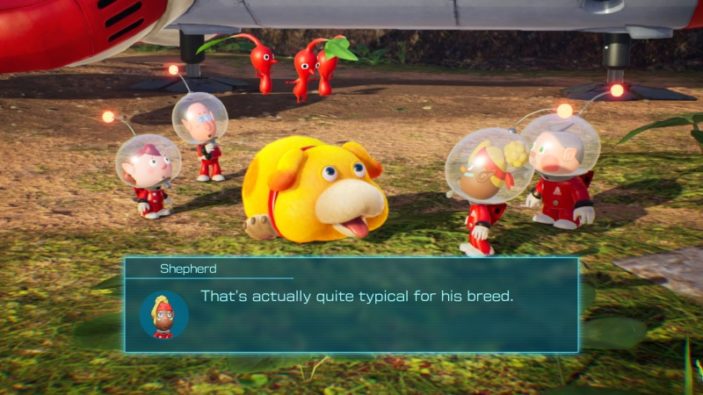
Nintendo’s sequels are somewhat known for how long they take to brew. Pikmin joins the ranks of Metroid, Fire Emblem and Zelda as one of Nintendo’s most iconic yet elusive properties, to the point you’d be forgiven for forgetting the Pikmin franchise even existed. The last numbered title was released way back in 2013 back on the infamous Wii U, before getting a Switch release in 2020. Before that, kid gamer Tony Ling played Pikmin 1 & 2 on the public Gamecube in his local Westfield’s K-Mart which were released in 2001 and 2004 respectively, before their refreshed Wii release. Pikmin 4 was first announced back in 2014… That is Final Fantasy XV levels of patience for fans of this beloved franchise, but now the decade-long wait for Pikmin 4 is finally over in all its Pikmin glory.
Pikmin 4 may just be the world’s whackiest RTS take on fauna versus flora. As a tiny alien astronaut, you navigate an abandoned Earth, commanding an army of Pikmin to fight enemies and retrieve treasure, resources, and defeated creatures for scientific profit.
Take Me to Your Leader
What is a Pikmin you ask? Well, they’re cute plant minions that look like walking, talking and incredibly agile sprouts that come out of the ground or a piece of floating garlic with legs which is dubbed in-game as…an onion, although, they can be reinforced with extra garlic-looking Flarlics that you find in the wild. Paradoxical veggie identities aside, these Pikmin come in all shapes and sizes with different colours to symbolise different powers.
For example, a blue Pikmin specialises in water abilities, while a red Pikmin excels in combat. There are many Pikmin types each with their own unique strengths and weakness as well as key abilities that help you solve puzzles and navigate through the world. The key is managing the best trio of different Pikmin to deal with your varied opposition. This involves you hurling your Pikmin at enemies and obstacles alike in order to succeed, as your levels are played out as a time-limited day with a clock on the top left showing your time ticking towards sunset.
The story continues from the events of Pikmin 3 where our legendary astronaut, Captain Olimar, returns to planet PNF-404 (Earth after all the humans left) only to crash land his ship and gets lost. He sends out a distress signal before disappearing and it’s now up to a team of intergalactic Rescue Corps to find Captain Olimar and bring him to safety. If that wasn’t enough, the entire Rescue Corp’s ship malfunctions on arrival, forcing everyone in the Rescue Corps crew to eject and get themselves lost across the planet while their ship crash lands too. And so then that’s where you come in – the Rescue Corps’ freshest recruit, chosen to rescue and reunite everyone from the rescue corps stranded across this planet, repair the crashed ship, and save the one and only Captain Olimar.
There are new Pikmin types like the ICEconic light blue Ice Pikmin that can freeze enemy monsters if they hit it frequently enough as well as being able to freeze water if you throw enough of them in the water. The reason why I gave such a terrible pun for this Pikmin is that they’re a bit of a crutch when dealing with enemy monsters since freezing it can be so effective in neutralising any worrying attacks they can do that can potentially kill your Pikmin in one fell swoop. And just like any meaningful RTS, you do not feel good losing your precious troops. Especially if they’re Pikmin.

When a Pikmin dies, it’s like a bit of your soul dies with it. And it’s not just because a literal ghostly soul animates itself out of a dead Pikmin on the field and disappears with the saddest noise you’ll ever hear from a virtual piece of flora. It’s because their unique abilities and power in numbers make them such a disadvantage if you lose too many of them not just in the heat of battle, but for the entire level/day.
Sure, you can replenish some of them from your garlic/onion-like craft that spawns next to your rocket base at the beginning of each level, but as certain Pikmin varieties are limited in findable quantities across the game world, they are not able to be replenished from your onion if they die. The game does recognise this and would not only spew out many mournful, big dialogue boxes from your supporting characters whenever too many of your Pikmin die, but the game lets you rewind in time if you feel like you accidentally lost too many or even all of a particular type of Pikmin (for the latter, it’ll even make a point of suggesting you to rewind). Luckily though, the gameplay difficulty is not too high.
If you know how to handle your Pikmin as well as your companion dog (which we’ll get into in just a sec), having a good read on your monster’s patterns and attacks would usually ensure you do not lose many casualties in battles unless you were really careless (or unlucky).
Marley and Me
Another major new addition is Oatchi your ginormous dog companion. This cute pup that’s double your size is one pretty impressive canine. Whilst also being able to do many things your Pikmin can do except ten thousand fold in greater strength like carrying, digging and attacking enemies, he can also do a range of skills like sniffing out and bringing you to a potential treasure as well as being a mount for you and all your Pikmin friends. He’s even upgradeable, which increases the strength of pre-existing abilities as well as adds new potent skills to his arsenal.

Having a mount may not sound like a revelation, but it certainly adds to the experience in unique ways. For one, once you mount on Oatchi, all of your Pikmin follow suit like a massive living ant colony on four canine legs. This is incredibly helpful as if you’re leading your Pikmin on foot, they do follow you, but it can feel like herding a heap of sheep as it clutters your astronaut and the environment leading to less pack control especially when the enemies start charging. You’ll constantly be spamming B to blow your whistle, which wrangles all Pikmin in a tight radius around your astronaut to come back to their leader.
The campaigns involve using Pikmin and Oatchi for rescue missions one day at a time across little open-world hubs. These worlds are filled with creatures, treasures, and lost astronaut friends. Some are part of your rescue corps, while others are infected adventurers (Leaflings) in need of a cure. These cure vials are obtained from the night missions where you play a tower defence version of your daytime levels where you only command one type of Pikmin that glow green and kick enemy butt while able to recover more resources across the game world to recruit more Pikmin.
For Relaxing Times, Make it Dandori Time
You also come across the game type of ‘Dandori’ in the dungeons of your campaign game world. This is where a Leafling challenges you to a mini-game to get as many points as possible by beating and harvesting the treasures, resources and monsters around you (and from each other) under a time limit. ‘Dandori’ is the Japanese concept that the game describes as: “organise tasks strategically and working effectively to execute plans”. It’s the heart and soul of the very gameplay you produce in your day-to-day adventures but comes in two modes for solo and competitive head-to-head. The first is Dandori Challenge where you’re beating a high score time limit style. The other is Dandori Battle where you’re doing it against an AI Leafling. It’s an obvious training component to the multiplayer mode where you can verse another human player. It’s definitely pandemonium at times, but still great competitive fun.
The campaign’s progression can also be incredibly rewarding. Before each day’s level, you will find so many lost astronauts you’ve accumulated populating your home, each with their own little side stories, many of which offer their own side missions of completing this number of x, y or z to get more currency for you to upgrade both yourself and Oatchi.

Discovering new ‘Flarlics’ in the campaign world also boosts your maximum Pikmin count in increments of ten. It’s truly rewarding to witness your Pikmin army grow permanently, knowing their strength ultimately lies in numbers. Different coloured Flarlics allow recruiting various Pikmin back at your base. As some Pikmin can only be found and recruited in the wild, it’s also worth noting that not all have their own Flarlics.
Some new Pikmin types lack essential power compared to the initial four. The last two Pikmin types feel more niche and decorative, with limited impact on the campaign. Later adventurers don’t offer significant side hustles and their stories vary in quality. The gameplay is a highly unique RTS experience, one that I cannot cover all of its nuanced features and gameplay in a single review. But it may not appeal to everyone due to its intricate nature.
Final Thoughts
Pikmin 4 caters to both newcomers and veterans, even if it seemingly compromises for a middle ground. It introduces features for easier gameplay but manages to add some unique and fun elements for returning and hardcore fans alike.
As a result, Pikmin 4 is by far the most unique gaming experience I’ve had on the Switch, let alone any other platform this year. If you love strategy games, puzzles, and feeling a sense of organisation in your life, this may just be your quintessential game of 2023.
![]()
![]()
![]()
![]()
![]()
FOUR STARS (OUT OF FIVE)
Highlights: Unique strategy gameplay; charming atmosphere; satisfying rewards and progression
Lowlights: Inconsistent quality in writing; some Pikmin types aren’t as meaningful
Developer: Nintendo EPD
Publisher: Nintendo
Platforms: Nintendo Switch
Available: Now
Review conducted on Nintendo Switch with a pre-release code provided by the publisher.

